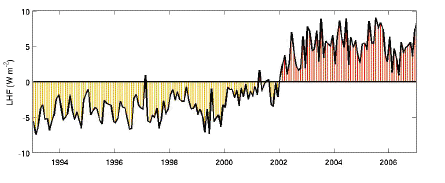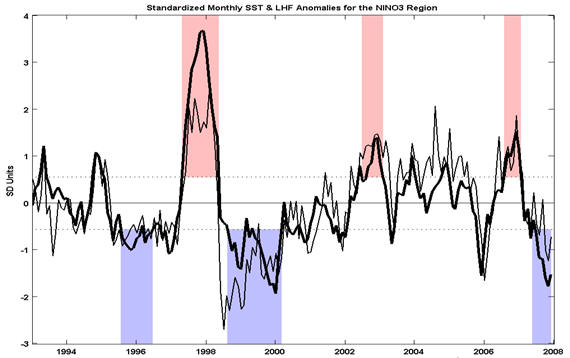|
Collaborative Research Atlantic Air-Sea fluxes from satellites, their variability and analysis of ocean models Department of Atmospheric and Oceanic Science University of Maryland, College Park |
| Background | |
|
|
Approach |
|
|
Data Sets Used |
|
|
Results |
|
|
Available Data |
|
|
Publications |
|
|
Outreach Activity |
|
|
Acknowledgements |
|
|
Contacts |
|
|
References |
| Back to Front Page | |
Intraseasonal latent heat flux based on satellite observationsWeekly averaged satellite based estimates of latent heat flux (LHTFL, positive if the ocean loses heat) are used to characterize spatial patterns and temporal variability in the intra- seasonal band (periods shorter than 3 months) (Grodsky et al., 2009). The strongest zonally averaged intra-seasonal variability of LHTFL in excess of 30 Wm-2 is observed at mid-latitudes in the zonal bands 40° S-10° S and 10° N-45° N. Intra-seasonal variability of LHTFL is locally stronger in the regions of major SST fronts (like the Gulf Stream, Agulhas current) where the standard deviation of intra-seasonal LHTFL is up to 50 Wm-2. The amplitude of the intra-seasonal LHTFL decreases at high latitudes and in the regions of equatorial upwelling, reflecting the effect of decreased SST. In mid-latitudes, the intra-seasonal variability of LHTFL is forced by passing storms and is locally amplified by unstable air stratification over warm SSTs. Although weaker in amplitude, but still significant, intra-seasonal variability is observed in the tropical Indian and Pacific Oceans due to the eastward propagation of Madden-Julian Oscillations. In this tropical region the intra-seasonal LHTFL and incoming solar radiation are out-of-phase, namely, evaporation increases just below the convective clusters. Over much of the global ocean anomalous LHTFL provides a negative feedback on the underlying intra-seasonal SST anomaly, although there are considerable geographical variations. The feedback exceeds 20 Wm-2/°C in regions around 20°S and 20°N, but decreases at high latitudes and in the eastern tropical Pacific and Atlantic where the time average LHTFL is weak. Trends in oceanic evaporation from 15-years of satellite observationFifteen years of a satellite based air-sea turbulent flux dataset (IFREMER) is used to investigate temporal trends in global oceanic evaporation (Kelly et al., 2011). Globally, the satellite estimates show a positive trend (Figure 1) indicating an acceleration of the oceanic evaporation during this period. The evaporation trend is not uniform in space with higher evaporation rates over the lower latitudes. The picture is consistent with an acceleration of the hydrological cycle as expected in a global warming climate. The magnitude of the evaporation trend is quantified and its significance discussed in the context of the observed variability in other climatic variables.
The ENSO signal in 15-years of satellite derived oceanic evaporation
Mestas-Nuņez et al. (2011) studied the variability of the seasonal anomaly of weekly-averaged latent heat fluxes over the global oceans using a 15 year satellite-derived dataset from IFREMER. Analysis of corresponding 15-year sea surface temperature and latent heat flux anomalies in the tropical Pacific (Figure 2) confirms that the 1997-98 El Niņo dominates the variability.
|
||||
|
|

